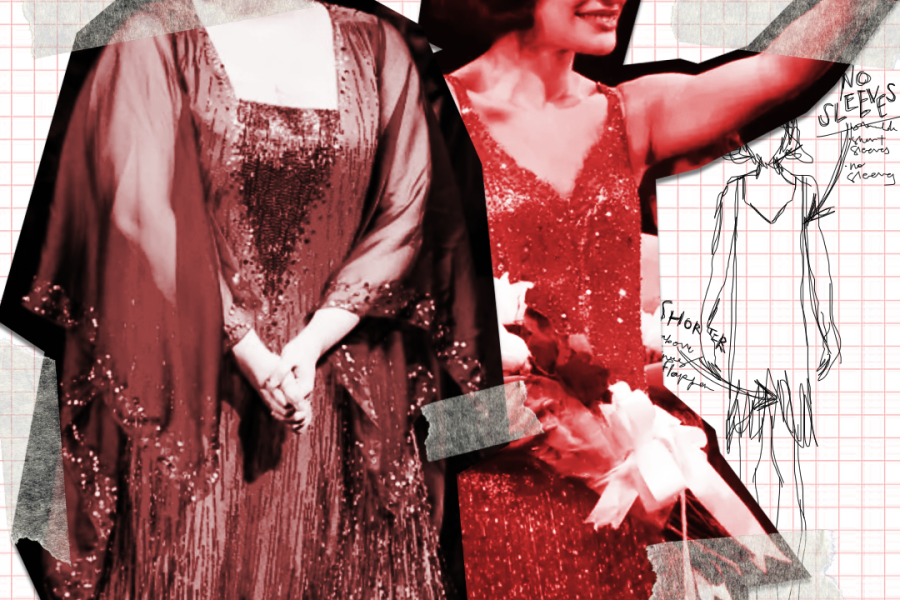Not So ‘Funny Girl’: The Evolution of Fanny Brice’s Costume and Its Fatphobic Connotations
Beanie Feldstein’s, Julie Benko’s and Lea Michele’s different finale costumes illustrate fatphobia on Broadway
The role of Fanny Brice has been played by Beanie Feldstein (left), Lea Michele (right) and Julie Benko (not pictured). Each actress wore a different finale dress with varying levels of modesty, and the public is attributing this decision to fatphobic body standards.
October 12, 2022
Hello gorgeous! Let’s talk about Broadway, shall we? The revival of the hit Broadway musical “Funny Girl” has faced a great deal of scrutiny since it opened on Broadway just six months ago. Three actresses have already played the role of leading character Fanny Brice, something that has confused fans worldwide.
Still, the most controversial change comes in the form of a red beaded dress that is worn during the finale of the show. This mid-length dress was adorned with long sparkly sleeves and a gold neckline that covered the actress’ cleavage. Following Beanie Feldstein’s sudden exit from the show at the end of July, the costume underwent abrupt changes in the length and size of the sleeves.
TikTok user @alainanoelleo was one of the first to highlight these changes. She commented that it took “no more than 3 seconds to remove the sleeves and change Fanny Brice’s final dress after Beanie Feldstein. You can say whatever you want about it. As a bigger-bodied person, it was noticed, felt, and noted.”
Julie Benko, Feldstein’s slimmer understudy, took over the role during the summer and saw her final dress transformed into a sleeveless and somewhat shorter one. This change raised some eyebrows at the time, but Benko’s talent overshadowed the controversy. However, all previous suspicions were confirmed when Lea Michele stepped into the role with an even shorter, lower-cut finale dress. Like Benko, this Glee actress is notably thinner than Feldstein, so her debut in this completely new costume came as a big shock. This move ignited a debate about fatphobia on Broadway and the tendency to favor slimmer actresses.
Broadway has been asking actors to lose weight for parts for years, so the issue of fatphobia in theater is not a new topic. One recent case was that of André Jordan who, in an interview with the Los Angeles Times from May 2021, commented that he was asked to lose 15 to 20 pounds for his ensemble role in the musical “Legally Blonde.” To add insult to injury, the interview was conducted in response to a New York Times article written during the pandemic where Broadway producers claimed performers had “gained weight” during lockdown.
What shocked “Funny Girl” fans the most, however, was the contradiction between this controversy and the topic of the show. The storyline follows an imperfect showgirl who struggles to make it in a demanding industry. She has to go against social prejudices in order to gain the fame and success she always wanted. For a show that prides itself on celebrating individuality and the beauty of imperfection, these costume decisions seem confusing and contradictory.
After Beanie Feldstein’s departure, she noted on her instagram that “The production decided to take the show in a different direction” and thus, she decided to cut her run short.
Nevertheless, there could also be a different way of looking at all of this. Though the optics are less than ideal, it is important to consider that these changes may just be a form of comfort. There has been no official confirmation as to who ordered these alterations, so who’s to say it wasn’t the leading ladies themselves? Often, actors work in collaboration with costume designers to create pieces they can feel comfortable in. This dynamic may be the case for the actresses in “Funny Girl.” This could be especially true as this was the only costume to be changed after the end of Feldstein’s run. Additionally, this is not a new idea, as other productions such as Six and Hamilton are known for customizing their costumes for every actor that takes on a new role.
Another possible reason for this change is that the producers wanted to mark a new chapter in the show. After Beanie Feldstein’s departure, she noted on her instagram that “The production decided to take the show in a different direction” and thus, she decided to cut her run short. Feldstein was heavily criticized during her time in the show, so the production may have redesigned the costume to mark a new change. Indeed, it appears this idea has worked, as Lea Michele’s run has been little short of perfect, with glowing reviews all around.
The production of Funny Girl has not addressed any of these claims at this time. It is clear that these changes would send the wrong message, and I truly do believe their public relations team could have seen this coming.
Situations such as these shed light on the issue of fatphobia in Broadway and how this matter needs to be discussed. The musical theater industry prides itself on celebrating differences and the uniqueness of their characters. What we can only wish for now is that producers grant the same courtesy to the actors portraying these roles. After all, it is way more interesting to be a bagel on a plate full of onion rolls!

















Richard • Oct 14, 2022 at 9:54 pm
The moo-moo was the perfect design for Ms. Feldstein, but you forgot to mention she TANKED the show. Lea Michelle received rave reviews and multiple standing ovations during her performance. Lea has literally saved “funny girl” and she should not be forced to wear something so ugly and unflattering.